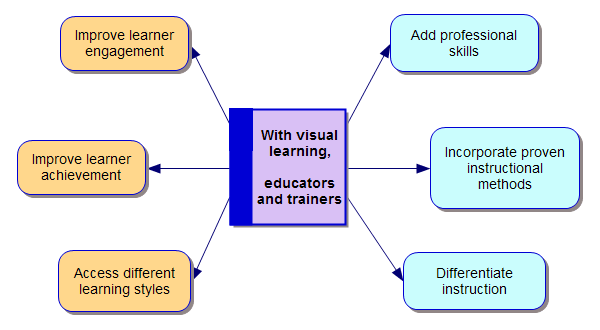About Visual Thinking
What is Visual Thinking?
Visual thinking, also called visual learning, is a proven method of organizing ideas graphically - with concept maps, mind maps and webs. Scientifically based research demonstrates that visual learning techniques improve memory, organization, critical thinking and planning.
Visual thinking is an intuitive and easy-to-learn strategy that works for many academic and professional projects. The more complex the task or idea, the more useful this approach can be. Visual thinking is a strategy that benefits people of all ages.
Visual Leap programs use visual thinking software as a learning tool, and this software accelerates the learning process.

According to studies conducted by the Institute for the Advancement of Research in Education, visual learning techniques improve:
- Test scores
- Writing Proficiency
- Long-term Retention
- Reading Comprehension
- Thinking and Learning Skills
Visual thinking is intuitive. After capturing and refining ideas with simple visual thinking software, one can export and seamlessly work with diagram files in programs like Power Point, Word, Adobe PhotoShop, and even into complete web sites.
Visual thinking is easy to learn. The strategy is transferable to many tasks, and the opportunities to use these tools and strategies are limitless.
| Visual Thinking Increases Productivity | ||
Visual thinking provides individuals with a hands-on strategy to self-start projects and assignments. It facilitates self-monitoring of one's progress and helps one stay on task and complete projects. Visual thinking decreases procrastination and increases independent problem solving.
At its essence, visual thinking increases productivity because is separates the cognitive "thinking" task of developing the content of a project or report, presentation from the mechanical - but time consuming - "doing" task of delivering the idea in its final form. This is true with any deliverable, whether it is a written report, PowerPoint presentation, or web site. This key separation of “thinking” and “doing” allows one to work more efficiently on both parts of a project. |
||
| Benefits to Learners | ||
Visual thinking provides students with strategies to work with concepts in a self-directed and hands-on way that allows them to "see" their ideas develop. By diagramming ideas – as opposed to writing ideas down in sentence form - individuals can actually see the strength, weakness, order and gaps in their hypothesis, argument or content. This process shaves many hours from the writing process because one begins to write or create a presentation only when the ideas are refined and well developed.
With training in visual thinking, students learn to brainstorm, plan, outline, organize research, synthesize information, write, present, evaluate, comprehend and communicate more effectively. |
||
| Benefits to Teachers and Trainers | ||
Educators benefit from visual thinking because visual thinking methods allow them to organize and frame information in easy to understand contexts. Assignments and instruction conducted with visual approaches add levels of differentiation to teaching and learning. Information delivered with visual learning techniques decreases reliance on text and lecture, and increase the understanding of relationships between ideas.
From pre-writing exercises for children learning to write to multi-faceted projects for older students writing essays and creating presentations, visual thinking strategies make complex tasks easier and more manageable. |
||
| How Visual Thinking Works | ||
The question of how visual techniques work to enhance thinking, learning, and problem solving has been studied in academic psychological studies and explored by popular psychologists. Findings include:
|
Views: 1013
Tags:
Welcome to
THE VISUAL TEACHING NETWORK
About
© 2025 Created by Timothy Gangwer.
Powered by
![]()

 Clarify thoughts
Clarify thoughts 

You need to be a member of THE VISUAL TEACHING NETWORK to add comments!
Join THE VISUAL TEACHING NETWORK